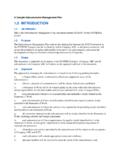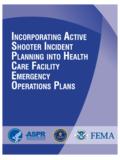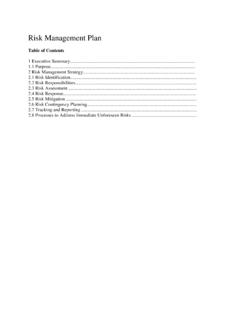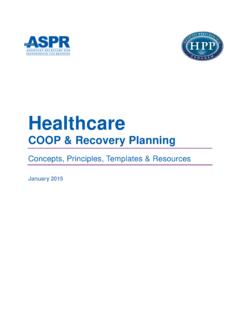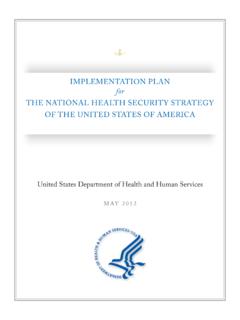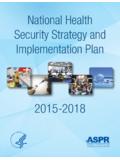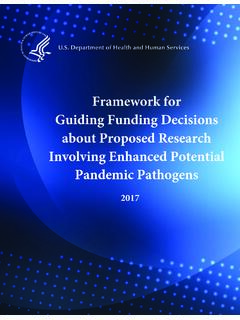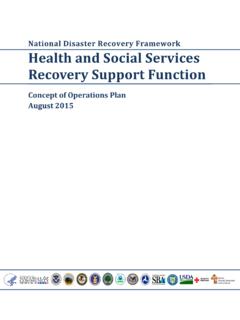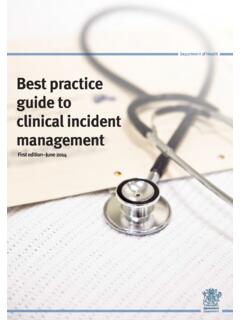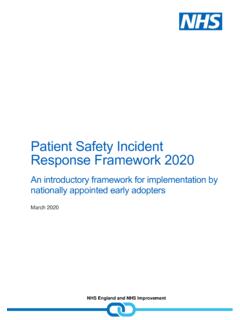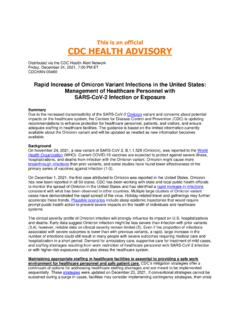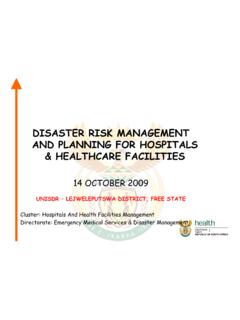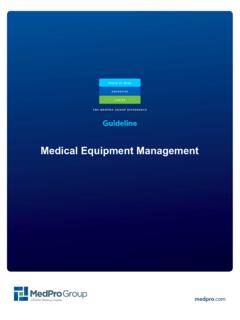Transcription of COVID-19 Healthcare Planning Checklist
1 Page 1 of 11 COVID-19 Healthcare Planning ChecklistHover over form fields for for a potential emerging infectious disease pandemic, like COVID-19 , is critical to protecting the health and welfare of our nation. To assist state, local, tribal, and territorial partners in their Planning efforts, the Department of health and Human Services (HHS) Office of the Assistant Secretary for Preparedness and Response has developed the following Checklist . It identifies specific activities your jurisdiction can do now to prepare for, respond to, and be resilient in the face of COVID-19 . Many of the activities in this Checklist are specific for COVID-19 , however many, pertain to any public health emergency. This Checklist is adapted from a variety of HHS Pandemic Influenza Pandemic Planning resources. It is not intended to set forth mandatory requirements by the Federal government.
2 Each jurisdiction should determine for itself whether it is adequately prepared for disease outbreaks in accordance with its own laws and authorities. We strongly encourage continued review of HHS Centers for Disease Control (CDC) COVID-19 guidance which is available on their website for the most current information. 1. Safety / Infection Control Activities ActivitiesCompletedIn Progress Not Develop a pandemic safety plan and appoint a safety officer to modify as required. Develop an agency/facility pandemic safety plan and appoint a safety officer to modify as Provide staff education about COVID-19 infection control and update polices as required. Support N95 respirator fit-testing for all agency/facility employees and just-in-time education on recommended infection control precautions including fit checking, applying simple mask to patients with cough, and hand Monitor availability of N95 respirators/powered air purifying respirators (PAPRs) and other supplies including alcohol-based hand disinfectants, gloves, etc.
3 , and watch and alert coalition members to supply shortages. Make recommendations on possible Prepare guidelines for conservative and re-use of N95 respirators/PAPRs if severe shortages are imminent (ideally regionally and in conjunction with local public health , occupational safety, and infection prevention providers and agencies - for example, consider use by only the highest-risk staff, re-use in selected situations, continued use while working on cohorted units, etc.). Plan contingencies if appropriate levels of respiratory protection are unavailable. Develop guidance for staff monitoring for signs of illness (including self-reporting, self-quarantine, and start/end of shift evaluation) and create a mechanism for reporting both illness and Develop a return to work post illness policy for health care workers.
4 This should be as consistent as possible across the coalition. Encourage HCFs to plan for staff access to medical care for themselves and their families; determine whether illness will be handled as workers' compensation or personal insurance depending on situation/criteria and share best practices. Determine contingency plan for at-risk staff ( , pregnant, other defined risk groups) including job expectations and potential alternate roles and locations. Evaluate the need for family support to enable staff to work ( , childcare, pet care ). Provide information for family care plans. Page 2 of 11 2. EMS Activities ActivitiesCompletedIn Progress Not Determine coordination mechanisms, scope, and likely authorities between coalition EMS agencies including information sharing, resource monitoring/assistance, and policy coordination.
5 Work with local intelligence fusion centers to assist with information sharing and Determine actions that the state EMS agency is likely to take including: Suspension or modification of operational requirements for EMS agencies Specific emergency orders or actions that may limit liability and/or expand scope of operations Determine local ordinances or laws that may affect EMS disaster operations and the authorities or ability to suspend or modify if needed to support non-traditional Evaluate available indicators that may be needed for Planning or by other partners and how to track them, , EEI such as number of transports, number of potential COVID-19 cases, staff Evaluate indicators that have effects on EMS and coordinate access through the health care coalition ( , status of emergency departments, alternate care sites, epidemiologic information/forecasting, weather ( , snowstorms), availability of staff, availability of supplies).
6 Determine vulnerable supplies and coordinate with vendors and the health care coalition to develop contingency plans/allocation Develop public messages that emphasize using 911 only for life-threatening emergencies and coordinate with the joint information Develop information sharing process both for internal staff and between EMS Develop just-in-time education for EMS personnel relative to infection prevention and control, self- care , transmission and family protection, and normal stress Pre-identify strategies and resources to ensure behavioral health support for staff to mitigate adverse stress and grief and loss reactions. Determine virtual coordination mechanisms that will enable remote engagement of senior staff to prevent exposures and maximize ability to engage in both daily and incident Determine how agency/regional EMS incident action plans will be Prepare to initiate auto-answer/recorded answering of 911 calls including diversion of information or non-emergency calls to another call center ( , public health hotline).
7 Consider activating a community hotline if such a call center does not exist. Evaluate protocols for conducting call screening to recognize COVID-19 -like symptoms ( , cough and fever) and advise the responding EMS personnel of a potentially infectious 3 of 11 2. EMS Activities (cont'd) Dispatch ActivitiesCompletedIn Progress Not Adjust response configurations to allow flexibility including: Prioritization of calls for service (for services that do not currently use priority dispatch systems) including basic algorithms for non-medically trained dispatchers or referring calls to recorded information, nurse triage hotlines, public health information lines, or other technology-based systems Recommending self-transport or referral to primary care if appropriate (may need to triage calls to medical provider to evaluate if this capability is available) Assignment of less than usual resources ( , assign law enforcement only on injury accidents unless and until clear information that non-ambulatory/critical injuries a represent) Assignment of non-traditional resources ( , using `jump' cars, community paramedicine, and other responses)
8 Diversion to an alternate care site Increasing interpretive service assistance Response ActivitiesCompletedIn Progress Not Develop triggers for implementing closest hospital transport - ideally done Develop triggers for implementing `batch' transports ( , answering another call immediately if your current patient is stable) - ideally Determine indicators and triggers for changing staff shifts and crew configuration - ideally this should be implemented consistently in the Provide criteria for patient assessment and emphasis on cough/respiratory and hand hygiene as well as strict adherence to appropriate infection control precautions per Centers for Disease Control and Prevention (CDC) Develop criteria for on-scene denial of transport by EMS personnel for COVID-19 -like illness and other patients - with or without on-line medical control - ideally regional rather than agency-based criteria and Develop/provide patient information sheets on homecare for COVID-19 -like illness including usual clinical symptoms and course, infection prevention, treatment, and when to seek additional medical Develop/provide patient information sheets for other conditions that may be left without transport if the service volume suggests a relevant need ( , minor injuries).
9 Determine alternate transport resources and triggers to utilize them, , private ambulance, wheelchair, contract/courier, for hire vehicles, military assets, Evaluate available staff vs. available transport units to determine ability to meet other non-transport missions ( , community paramedicine, EMS personnel staffing alternate care locations or providing hospital support). Determine necessary changes to record-keeping including use of 4 of 11 3. Hospitals and health care Activities Coordination Regulatory ActivitiesCompletedIn Progress Not Determine coordination mechanisms, scope, and likely authorities between coalition hospitals and health care systems including information sharing, resource monitoring/assistance, and policy coordination. This should include the role of the coalition to engage with vendors of PPE, pharmaceuticals, and other medical supplies that may be in shortage.
10 Conduct a coordination conference call with Healthcare facilities to ensure awareness and Determine mechanism to engage outpatient settings (homecare, ambulatory care ) in information sharing and policy/response Determine mechanisms to engage skilled nursing facilities in information sharing and policy/response Determine actions that the state of emergency management or public health agency is likely to take that affect health care including: Suspension or modification of requirements for hospitals or clinics Specific emergency orders or actions that may limit liability or expand scope of operations (for facilities and providers, including volunteers) Requests for 1135 waivers from the Centers for Medicare & Medicaid Services (CMS) Crisis standards of care activation Issuance of clinical guidelines for care and resource allocation 'Taking powers' of the state relative to medical materials and staff ( , does the state have ability to commandeer resources under their emergency powers and does this include medical materials?)
